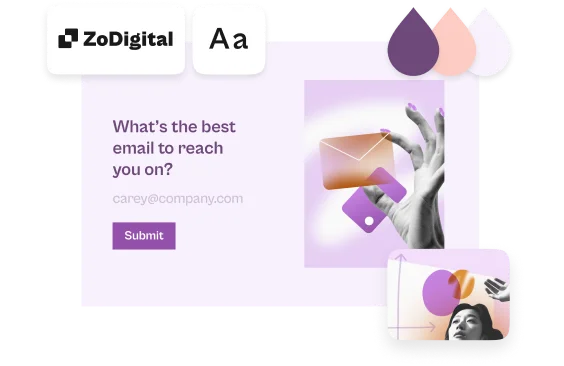Create Workflows for your form
We're currently testing how to access a few features within Typeform, so you might see something different in your account. In this article you’ll find a brief overview of the features that have been moved and how to find them in the Workflow panel of your form.
Within the Workflow panel, you can do the following:
- Add logic (branching, segmentation, calculations, score quiz, outcome quiz)
- Pull data in through URL parameters (previously called Hidden Fields and UTM tracking)
- Send messages (previously called follow-ups)
- Send Typeform data to other platforms (connect to integrations)
To access the Workflow panel, open your form and click Workflow in the header.
Add logic (branching, segmentation, calculations, score quiz, and outcome quiz)
With logic, you can add branching to skip respondents to different questions in your form based on how they answered your form. This way, they won’t have to see questions that aren’t relevant to them. You can also segment your leads and add calculations to your form.
You’ll also be able to add scores to a simple quiz or create an outcome quiz, where you can link answers to different endings.
To add logic to your form, click Add logic and then you can select Branching, Score quiz, or Outcome quiz.
For more specific information on how to create logic in your forms, check out the below resources (keep in mind where to locate logic might be different than what you see in the resources below):
- Use segmentation to qualify leads
- Add calculations to your form
- Quiz and scoring: what’s the difference between Outcome quiz and Score quiz?
Add variables
Variables are numeric or text values that your form can keep track of. Score, price, and segment are the default variables. However, you can create as many custom variables as you want and track more than one score or whatever you'd like.
To access variables, click the (x) icon in the tool bar of the Workflow panel.
More information on how to add and change variables can be found here. Remember, where you locate variables in your account might look different from the linked article.
Pull data in through URL parameters (previously called Hidden Fields and UTM tracking)
URL parameters allow you to insert data you have about a respondent into your form’s URL. It’ll then pass the data you put in your form’s URL into your form results. For example, if you already know a respondent’s name and email, you won’t have to ask for this information in your form. Their response will be automatically attached to their contact information. You can also track sources and identify where traffic is coming from to your form.
To pull data in from your form’s URL, click the box labeled Pull data in within the Workflow panel.
A pop-up will appear and you can then toggle on any of the parameters you'd like to insert into your form’s URL.
You can also create custom URL parameters to track anything you’d like. Click + Add new parameter to create a custom URL parameter.
Then type in what you want to call the URL parameter (must be written in lower-case letters and use underscores for spaces) and click Save.
Your URL parameters will be added to your form’s share URL when you click Publish.
You’ll then be taken to the Share panel where you can copy your form’s link and enter in the data for your URL parameter(s).
Click Copy link, paste your link, then replace the xxxx with the data you want to pass into your form. In our example, we’ve added the URL parameter utm_source; we would then replace the xxxx with twitter or facebook for sharing on those networks. Our form’s link could look something like below:
https://surveys.typeform.com/to/Ax94FZRQ?utm_source=twitter
Once you’ve started collecting responses, you can see the data from the URL parameters in the Responses tab of your Results panel.
Send messages (previously called follow-ups)
After receiving responses from your form, you have the option to send messages to your respondents. Additionally, you can also send messages to yourself or your team upon someone completing your form.
Within the Workflow panel, click Send messages to communicate with your team and form respondents.
For more information on how to send messages, please read this article. Keep in mind where you locate messages (follow-ups) will be different in the article linked.
Send Typeform data to other platforms (connect to integrations)
With Typeform, you’ll be able to send the data you collect to other tools such as HubSpot, Google Sheets, and many others. To integrate your form with another platform, click Send data within the Workflow panel.
You’ll then see a list of integrations you can connect to. Check out our integration resources here for more information.
Trigger webhooks
Webhooks allow you to automatically send information to another application. To access webhooks, click on the Trigger webhooks option in the Workflow panel.
For more information on how to add a webhook, please follow the instructions here and skip to step 3 in the article.


